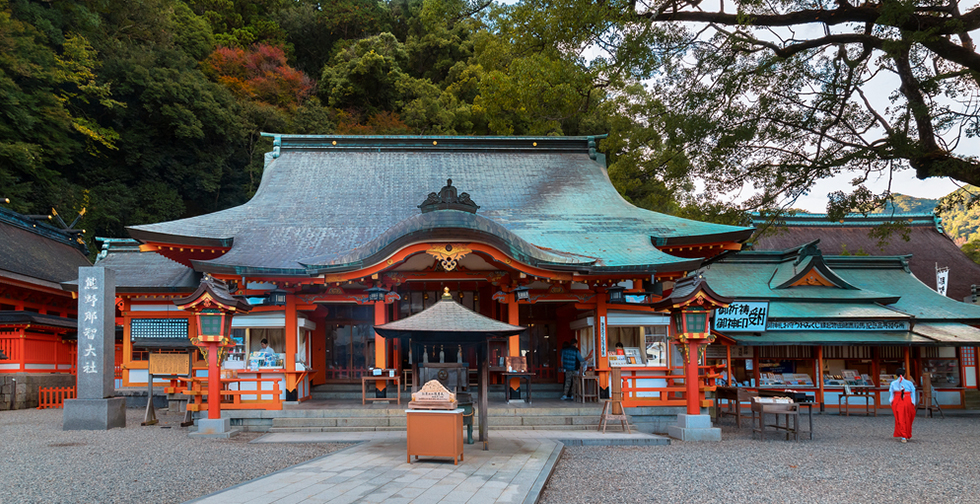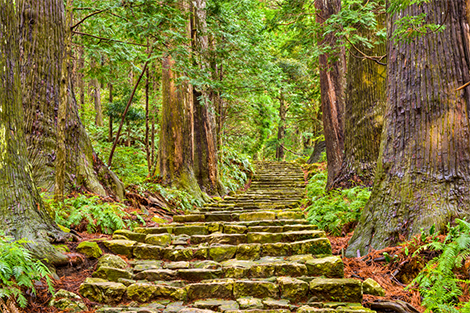 Popular spot
Popular spot
Kumano Kodo, a Scenic World Heritage Site

Kumano Kodo has been a popular pilgrimage destination for centuries.
It is essentially a series of old routes that connect the Kumano Hongu Taisha Grand Shrine, Kumano Hayatama Taisha Shrine, Kumano Nachi Taisha Shrine, Ise, Osaka, Wakayama and Yoshino.
Some of the routes were designated as UNESCO World Heritage Sites, and have now gained popularity as spiritual sites.
Here are some sites that you should be sure to include on a pilgrimage trip along the historic and naturally beautiful Kumano Kodo.
Kumano Kodo Routes
Kumano Kodo consists of the following five routes:
-
-
・Kiiji Route
A route that spans from Osaka to Tanabe, Wakayama. -
・Nakahechi Route
A mountainous route that connects Tanabe to Kumano Sanzan. -
・Kohechi Route
A route between Mt. Koya and Kumano Hongu Taisha Grand Shrine.*The road is called Koya-michi if you are leaving from Kumano Hongu.
-
・Ohechi Route
A coastal route that takes you from Tanabe to Kumano Sanzan. -
・Iseji Route
A route that spans from Mie’s Ise Jingu Shrine to Kumano Sanzan.
-

Of these five routes, the Ohechi, Nakahechi, and Kohechi Routes are designated as World Heritage Sites.
Kumano Sanzan
Kumano Sanzan is a comprehensive name for the three shrines of Kumano Hongu Taisha, Kumao Hayatama Taisha, and Kumano Nachi Taisha All three are designated as World Heritage Sites, and we highly recommend you visit them.
Kumano Hongu Taisha Grand Shrine
Kumano Hongu Taisha considered to be the most impressive of the Kumano Sanzan shrines. It is the first place you encounter on the Nakahechi route. Its hinoki bark-thatched shrine is designated as an Important Cultural Property.
It is also home to a well-known icon, a three-legged Yata-Garasu crow. As an avatar of the Sun, Yata-Garasu is said to have served the first emperor, Emperor Jimmu. Statues of this crow can be found by the shrine’s torii and gates.
Kumano Hayatama Taisha Shrine
Situated at the mouth of Kumano River, Hayatama Taisha is a spiritual site where gods of the twelve pillars, such as Izanagi and Izanami, are worshipped. The Nagi dolls, made of Nagi tree nuts in the shrine, are believed to bring good fortune in relationships and marriage.
Climbing the shrine’s 538 stairs will surely make you feel like you are on a pilgrimage.
Kumano Nachi Taisha Shrine
Originally a place to worship the Great Falls of Nachi as a deity, the Kumano Nachi Taisha shrine currently stands at location slightly away from the falls.
Nachi Taisha is home to Japan’s largest Omikuji - a box with fortune slips. As a reference to the 133-meter-long Nachi Falls, the fortune slip container is 133 centimeters long. This is a chance to have a unique experience using your whole body to pull out a fortune slip.
Hanano Iwaya
Hanano Iwaya enshrines a gigantic, 45-meter rock. It has remained as a place to practice nature worship, and thus do not involve any shrines or similar architectures. According to the oldest chronicles of Japan, Nihon Shoki, Hanano Iwaya is the grave site of Izanaginomiko who gave birth to a number of gods. Along with Kumano Kodo, it is designated as a World Heritage Site. Since the locals have worshipped this place since the ancient times, you may find yourself picking up some good vibes here.
Explore the Kumano area with a one-way rental car!
Famous for being home to World Heritage Sites, the Kumano area is not only a great place for experiencing pristine nature, but also caters to regional gourmet and landscape fans.
Unfortunately, however, train service is limited in the area in which Kumano Kodo is located.
Even if you are planning to visit sites that are within walking distance from the train station, renting a car once you have arrived at the station would be more convenient.
Why not explore Kumano by taking advantage of a one-way rental car system, where you can drop off the car at a different station from the one where you picked it up?


